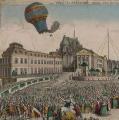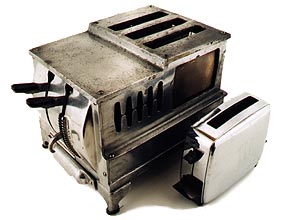
This post is a modest entry for the Your Nearest Site carnival....
In a Hampton cul-de-sac, a couple of streets from my house, an upturned cannon sits in the ground surrounded by a patch of grass in the middle of a small council estate.
It is a interesting relic of General William Roy's pioneering late C18th triangulation work which laid the basis for the Ordnance Survey.
The photo is courtesy the Twickenham Museum website, which tells the story of how Roy, a Royal Engineer, used triangulation to measure the distance between the Paris and Greenwich observatories. Until the advent of GPS, triangulation was the only means to measure distances over water.
The other end Roy's baseline, 5 miles to the north, is marked by another cannon in a slightly more noisy location on the perimeter road around Heathrow Airport.
To quote the Royal Engineers Museum site, "This line was measured in the summer of 1784, three times over, by means of cased glass tubing, seasoned deal rods and a steel chain. The discrepancy between these three methods was less than 3 inches".
23 July, 2007
Cannon fodder
Posted by
cardinal_wolsey
at
10:27 PM
0
comments
![]()
Labels: 18th Century History, Hampton, History of Inventions, William Roy
13 July, 2007
The Dean of St.Paul's invents bottled beer, 13th July, 1568
Cardinal Wolsey did not drink bottled beer. Why? Because he had been dead for 39 years when Dr Alexander Nowell, Dean of St Paul's is reputed to have discovered the benefits of bottled beer by accident.
According the the History of the Pint,
the Dean had decanted some beer into a bottle for a fishing expedition in 1568. He lost a bottle in the grass and, "when he came upon it again quite by chance a few days later, found it was still perfectly drinkable".
The Mary Rose website discusses the importance of copious supplies of beer to the Tudor navy : seven gallons per man was the norm.
Some interesting"annotations" on the subject of beer in the 17th century have been contributed by readers of the Samuel Pepys Diary blog . Pepys himself records the unfortunate consequences of drinking bad beer in the diary...
"Drinking of cold small beer here I fell ill, and was forced to go out and vomit, and so was well again and went home by and by to bed."(16 March, 1662).
["Small beer" was lower in alcohol than "Strong beer", and so more liable to contamination! ]
Posted by
cardinal_wolsey
at
9:57 PM
2
comments
![]()
Labels: 16th Century History, History of Inventions, naval history, Samuel Pepys, Tudor History
18 June, 2007
First life insurance taken out in London, 18th June, 1583
Although we know that Roman "burial clubs" were a form of life insurance, Alderman Richard Martin is generally credited with taking out the first Life Insurance policy proper. The policy was taken out on the life of William Gybbon, a salter (he preserved meat and fish).
Apparently the policy was a one-year term, and Gybbon died just before the year was up. True to present form, the underwriters initially refused to pay up on the grounds that the contract was for a lunar year. The courts however ruled in favour of Martin.
There is more information in the Annals of the American Academy of Political Science, 1905 : apparently Martin effectively wagered 30 pounds with 13 London merchants that Gybbon would die within the year, and on his death received 400 pounds - a large amount. Cause of death not recorded.........
Posted by
cardinal_wolsey
at
10:38 PM
3
comments
![]()
Labels: 16th Century History, History of Inventions, Insurance
16 March, 2007
Let them eat cake! Henry Jones invents self-raising flour. March 17th, 1845
 Henry Jones was fortunate amongst inventors in that he actually made a lot of money from his ingenuity, rather than see others turn his ideas into cash. Good for him.
Henry Jones was fortunate amongst inventors in that he actually made a lot of money from his ingenuity, rather than see others turn his ideas into cash. Good for him.
This is from an article by Eugene Byrne for the 2006 Bristol "Festival of Ideas".
" A baker and confectioner in Broadmead (Bristol), Jones patented his self-raising flour in 1845. Until then, the only raising agent used in bread was yeast, which would not keep. This meant that soldiers and sailors, particularly, had to consume bread and biscuit that would become almost inedible. Jones said it was concern for servicemen, just as much as profit, which prompted him to develop his invention".
Henry Jones strove to convince the Admiralty that although a diet of "maggots, weevils and mouldy biscuits" may have suited Nelson’s crews, only good bread, decently baked, would satisfy a modern seaman.
"It was quickly championed by Florence Nightingale, who could see the advantage in soldiers and sailors enjoying a decent diet and Jones also got a warrant from Queen Victoria to supply the royal household. An article in The Lancet in 1846 praised Jones Patent Flour for its “contribution to public health and to the daily comfort of the masses”. Jones made a small fortune, and then another with his arrowroot biscuits, which were cheap and hugely popular"
Here's a link to an interesting website on the history of Bristol firms , which has a longer article on Henry James & Co , which is still going strong.
Posted by
cardinal_wolsey
at
9:40 PM
0
comments
![]()
Labels: 19th Century History, Henry Jones, History of Inventions, naval history
12 June, 2006
12th June, 1839. Game of Baseball invented in USA (allegedly)

The Americans think that they invented baseball....but not so fast you colonial types. It might in fact be based on an old English folk-game called Base-Ball, as illustrated here.....
More details including a related ancient game called Stool-Ball (don't ask) can be found at : http://en.wikipedia.org/wiki/Origins_of_baseball
Posted by
cardinal_wolsey
at
10:48 PM
1 comments
![]()
Labels: 19th Century History, Baseball, History of Inventions
05 June, 2006
5th June, 1783. First Public Balloon Flight

The Montgolfier brothers make the first public balloon flight.
This from inventors.about.com...[incidentally, in their "what's hot" list, they have the history of frozen food.....geddit?]
"The Montgolfier brothers, born in Annonay, France, were the inventors of the first practical balloon. The first demonstrated flight of a hot air balloon took place on June 4, 1783, in Annonay, France.
Joseph and Jacques Montgolfier, paper mill owners, were trying to float bags made of paper and fabric. When the brothers held a flame near the opening at the bottom, the bag (called a balon) expanded with hot air and floated upward. The Montgolfier brothers built a larger paper-lined silk balloon and demonstrated it on June 4, 1783, in the marketplace at Annonay. Their balloon (called a Montgolfiere) lifted 6,562 feet into the air.
First Passengers
On September 19, 1783, in Versailles, a Montgolfiere hot air balloon carrying a sheep, a rooster, and a duck flew for eight minutes in front of Louis XVI, Marie Antoinette, and the French court.
First Manned Flight
On October 15, 1783, Pilatre de Rozier and Marquis d'Arlandes were the first human passengers on a Montgolfiere balloon. The balloon was in free flight, meaning it was not tethered.
On January 19, 1784, a huge Montgolfiere hot air balloon carried seven passengers to a height of 3,000 feet over the city of Lyons.
Montgolfier Gas
At the time, the Montgolfiers believed they had discovered a new gas (they called Montgolfier gas) that was lighter than air and caused the inflated balloons to rise. In fact, the gas was merely air, which became more buoyant as it was heated."
Posted by
cardinal_wolsey
at
11:02 PM
0
comments
![]()
Labels: 18th Century History, History of Inventions, Montgolfier Brothers
29 May, 2006
29th May, 1919. Invention of the Pop-Up Toaster

Charles Strite invented the pop-up toaster. -
This is from www.toaster.org (it's not the only toaster website...!)
"During World War I, a master mechanic in a plant in Stillwater, Minnesota decided to do something about the burnt toast served in the company cafeteria. To circumvent the need for continual human attention, Charles Strite incorporated springs and a variable timer, and filed the patent for his pop-up toaster on May 29, 1919. Receiving financial backing from friends, Strite oversaw production of the first one hundred hand-assembled toasters, which were shipped to the Childs restaurant chain. The first pop-up toaster for the home, the Toastmaster, arrived on the scene in 1926. It had a timing adjustment for the desired degree of darkness, and when the toast reached the preselected state, it was ejected, rather forcefully. The device stirred so much public interest that March 1927 was designed National Toaster Month, and the advertisement running in the March 5 issue of the Saturday Evening Post promised: "This amazing new invention makes perfect toast every time! Without turning! Without burning!" "
Check out this monster industrial-sized version with a later model shown for scale, from www.toastercentral.com
Posted by
cardinal_wolsey
at
10:45 PM
0
comments
![]()
